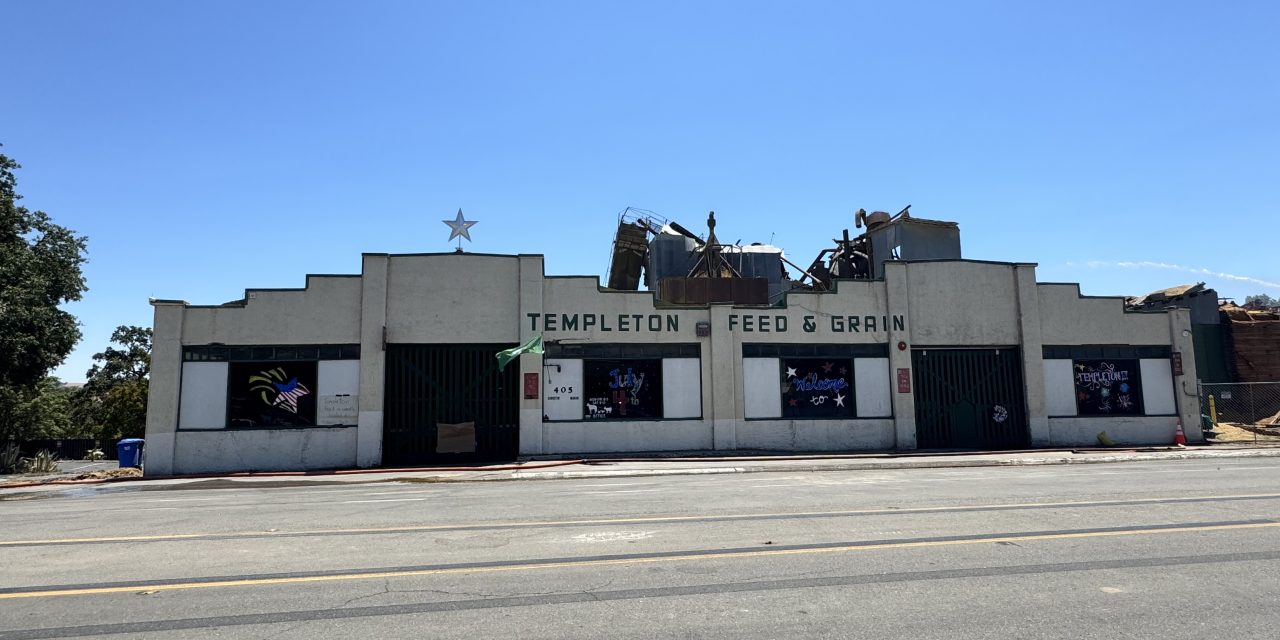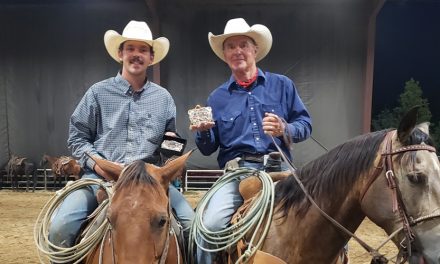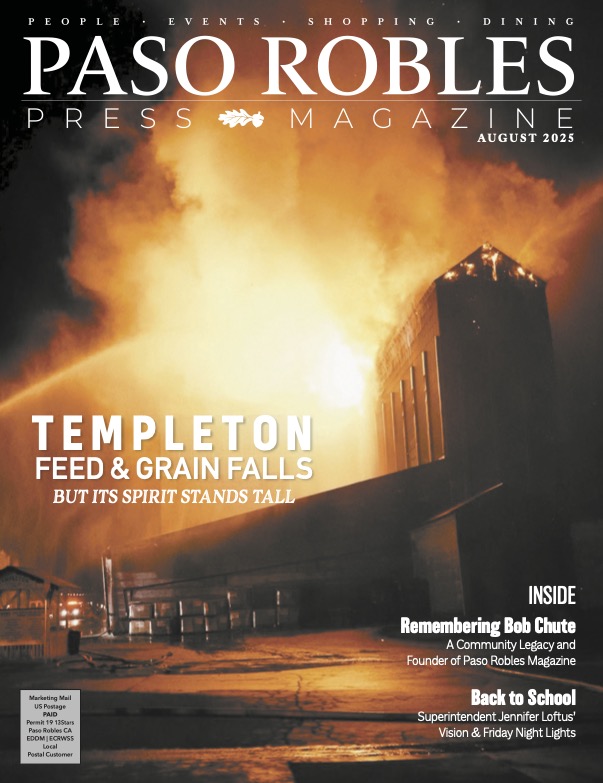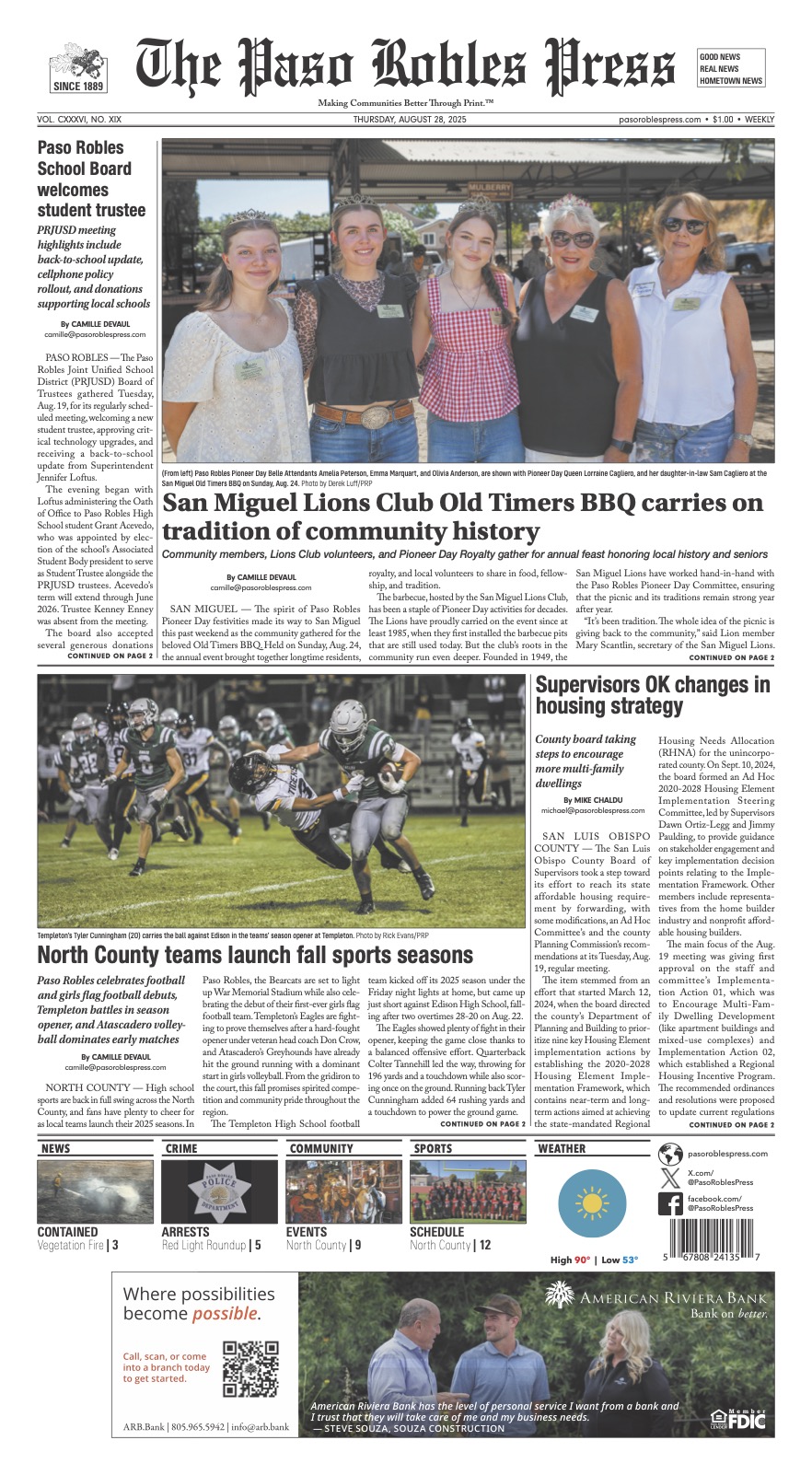After a Fourth of July fire destroyed Templeton’s iconic grain silos, owner Rick Jermin and his wife Stacey lead recovery efforts with transparency and resolve
By Hayley Mattson and Camille DeVaul
Feature Image by Hayley Mattson
TEMPLETON — The devastating fire that engulfed and destroyed the iconic grain silos at Historic Templeton Feed and Grain has left a void in the heart of Templeton, erasing a landmark that symbolized the town’s agricultural heritage. Owner Rick Jermin and his wife Stacey are navigating a complex path to recovery, balancing practical rebuilding plans with the emotional weight of community expectations.
“The devastating fire at Templeton Feed & Grain struck at the heart of our community — erasing not only a historic landmark, but a place filled with personal memories for so many of us,” said Gina Fitzpatrick, CEO of the Paso Robles and Templeton Chamber of Commerce. “I still remember riding in the old cattle truck with my grandpa, pulling up to the weigh scale, and feeling the deep connection to our town’s agricultural roots. This loss affects each of us in different ways, touching both our hearts and our Main Street businesses. As we grieve, we also look to the Jermin family with admiration for their strength, resilience, and unwavering commitment during such a challenging time. Templeton’s spirit is strong, and together, we’ll continue to support one another as we rebuild.”
The fire, which occurred at 11 p.m. on July 4, destroyed the historic wooden grain silos that had stood for generations, leaving behind a smoldering pile of grain and wood that remains a fire risk. “It could reignite if it gets enough air, so we’re keeping water on it,” Rick Jermin explained. The family aims to return to their original property within three weeks, once the debris is cleared. “We’re being loaned a portable office by Weyrick at no charge, and we’ll set up two 4,500-square-foot tents to store products,” Rick said. In the interim, they are staging inventory at Weyrick Lumber, with Rick transporting three pallets at a time to keep their temporary location at Nature’s Touch just down the street from their site operational.
The Jermins’ rebuild plan centers on preserving the iconic white cement storefront, a pour-in-place structure built in 1912, which sustained damage during the fire and subsequent demolition. “When they pulled down the debris, it broke the truss in the back corner and damaged the roofline,” Rick explained. “The front will look exactly as it always has to keep the historic feel, but the rest of the building will come down, and we’re putting up a metal structure behind it for the new feed store.”
This new design will be insurable, addressing a critical issue as the previous silos and much of the inventory were uninsured due to their age and construction. “That’s a big deal,” Rick emphasized. “None of our product was insured before, but now we can protect our investment.” The decision not to rebuild the silos stems from practicality. “Everybody is really hurt about the silos being burnt down, but we can’t rebuild them,” he stated. “There’s not enough grain grown here to justify that structure anymore, and even if we wanted to, it would cost millions due to the wood and engineering required.” The original building still houses manufacturing equipment, but moving it risks further damage to the compromised roof structure.
“The side walls are poured with shelves that the trusses span across,” Rick explained. “If those kick out, the roof comes down. We also found pre-existing damage when we cleared out feed, which we hadn’t seen before because the building was never empty.” The shift away from milling operations also necessitates more storage space for suppliers like Penny Newman, further justifying the redesign. Community support has been a lifeline for the Jermins. Chicago Grade Landfill, owners of the Templeton Landfill operated by Waste Management, waived disposal fees, a gesture that alleviated significant financial strain. “They called during the fire and said, ‘We’ve got your back,’” Rick recalled. “They even opened the facility on a Sunday to avoid disrupting their regular operations.” Local trucking companies and Andy Brown with ABI, have donated equipment, time and services, leveraging long-standing relationships. “People are just amazing,” Rick shared, highlighting a community-driven initiative where businesses matched donations for apparel sales, such as hats, to support the rebuild.
However, the Jermins are cautious about fundraising efforts, particularly those not authorized by the family. “We haven’t set up any GoFundMe or official donation drives,” Rick clarified. “Some people have given us cash, and I’m opening a separate account to segregate those funds for employee support and disposal costs, but we’re uncomfortable with people donating under the assumption we’re rebuilding the silos.” He stressed the importance of transparency, ensuring that any contributions are directed solely to the storefront rebuild. “We may need help with that small portion, but we want donors to know the plan,” he said. The family has a reserve fund to cover inventory restocking and employee support, but the cost of rebuilding may require limited community assistance.
A recent report mistakenly claimed that Templeton Feed and Grain planned to start selling feed online — a rumor quickly put to rest by owner Rick Jermin. “My nephew is building a website, but it’s only for apparel like hats and shirts, not feed,” Rick clarified. The Jermins have long sold branded apparel at cost, a tradition they’re proud to continue. “We’re honored people want to wear our hats, so we keep prices the same online and in-store,” he added. “If someone wants to donate more, that’s fine, but it’s not about profit.”
As the investigation into the fire that destroyed the historic grain silos continues, information remains limited. The Jermins are in communication with the sheriff’s department but, like the rest of the community, are still waiting for answers. “We don’t know who did it — no names, no ages, nothing,” Rick said. “We’re waiting for their announcement like everyone else,” Stacey added.
At the Templeton Community Services District (TCSD) meeting held on Tuesday, July 15, officials presented updates related to the fire. Templeton Fire Chief Tom Peterson shared a timeline of the response, noting that firefighters were on the scene within two minutes and had water on the flames just two minutes after that. The fire lasted several days and required an extensive effort to contain.
San Luis Obispo County Sheriff’s Office Commander Sandra Arauza also addressed the community, offering a brief update on the investigation. “Some people of interest have been identified,” she said. “That said, they still have some additional leads to follow up on. Once they conclude that, we, the sheriff’s office, will be putting out a press release regarding the investigation. But they have identified some individuals.”
Looking ahead, TCSD has scheduled another public meeting for Sept. 2 to further discuss fireworks safety and enforcement, including concerns around both safe-and-sane fireworks and illegal use — issues that have been top-of-mind since the blaze.
Despite the devastation, the Jermins remain focused on honoring the legacy of Templeton Feed and Grain while planning for its future. In a symbolic gesture, Rick placed the historic star atop the damaged adobe building — a nod to resilience, even if the angle was slightly off. “I thought I could sneak up there and drill it in quick, but someone got a picture and put it on Facebook,” he laughed. A more permanent, elevated placement of the star is being planned.
As they rebuild, the Jermins are encouraging the community to follow their official Facebook page for updates and reach out directly with questions. “We’re grateful for the support, but we want to do this right,” Rick said. “This is about keeping Templeton Feed and Grain alive for the next generation—for the community that’s stood by us. Even though it may look a little different, the heart of it remains the same.”














